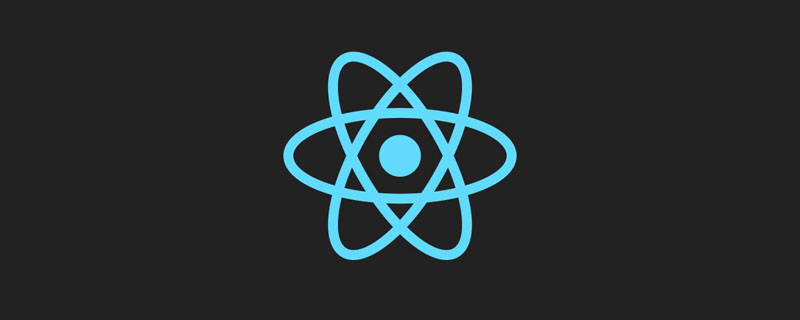What is react-dva?
In react, dva is a data flow solution based on redux and redux-saga. In order to simplify the development experience, dva also has built-in react-router and fetch, so it can also be understood as a lightweight application framework.

This method is suitable for all brands of computers.
dva introduction
dva official website address: https://dvajs.com/
dva is a single-page application framework launched by Ant Financial, which encapsulates redux, react-router, and redux-saga at the upper level. redux-saga is a middleware used to manage asynchronous operations of redux applications. redux-saga collects all asynchronous operation logic in one place for centralized processing by creating sagas. It can be used to replace redux-thunk middleware
-
This means that the application logic will exist in two places
(1) The reducer is responsible for processing the stage update of the action
(2) The sagas is responsible for coordinating those complex or asynchronous operations.
sagas are created through the generator function
sagas can be regarded as a process running in the background. Sagas listens to the initiated action, and then decides what to do based on this action (for example: whether to initiate an asynchronous request, initiate other actions to the store, or call other sagas, etc.
because Using the generator function, redux-saga allows you to write asynchronous code in a synchronous way
The React project introduces Dva
Introduction
- Project situation: nw.js react redux antd (client application)
- Goal: redux -> dva
Preparation
First install dva (current version 2.4.1)
npm install dva —saveRefer to the official documentation, transform the project into dva mode, add or modify the entry What is react-dva? under src
index.js
import dva from ‘dva’;
import createHistory from ‘history/createHashHistory’;
//1.Initialize
const app = dva({
history: createHistory(),
});
//2.Plugins
//app.use({});
//3.Model
//app.model(require(‘./models/app’).default);
//4.Router
app.router(require(‘./router’).default);
//5.Start
app.start(‘#root’);- Then add the routing What is react-dva? in the same directory
router.js
import React from ‘react’;
import { Router, Route, Switch } from ‘dva/router’;
import App from ‘./containers/App’;
import{ Account, Articles, Channels, Editor } from ‘./containers’;
const { ArticleList } = Articles;
const RouterConfig = (({ history }) => (
<routerhistory>
<switch>
<route>
<indexroute></indexroute>
<route></route>
<route></route>
<route></route>
<route></route>
</route>
</switch>
));
export default RouterConfig;</routerhistory> Description: The App component is the container component of the entire page, including menu, header, and footer And some common parts, by switching the menu to match the corresponding route, thereby jumping to each sub-component page, so the routing configuration needs to be written in a nested form.
For more routing configuration, refer to the react-router official documentation.
Here, the simplest dva mode has been configured. As long as you set the model and reducer in the corresponding component and connect in the page, you can use dva to manage the state.
Problem Solved
After the configuration is completed, restart the project and check the page effect as follows: 
It is found that the container part is successfully rendered, but the page corresponding to the sub-route (the default is Account ) was not rendered, and then I looked at the console and found that an error was reported.
1. First, there is such a warning message:
Warning: Please use `require(“history”).createHashHistory` instead of `require(“history/createHashHistory”)`. Support for the latter will be removed in the next major release.
Found the same problem in the issure of dva, and changed it to The following format will do.
const createHistory = require(‘history’).createBrowserHistory;
2. Then there is a warning about routing problems:
Warning: You should not use <route> and <route> in the same route; <route> will be ignored</route></route></route>
React-router 4.0 or above is no longer recommended to use nested routing like the following If
<route> <route></route> </route>
is found, just change it directly to the component nested form (note that / must be added to the path of the sub-routing).
<app> <route></route> </app>
After making the changes and trying again, these two warnings are gone. Continue to look at routing and rendering issues.
3. Logically speaking, the Account component will be displayed by default when entering the application (because IndexRoute is configured), and when the What is react-dva? is modified and the page is refreshed, the page directly reports an error, as follows: 
From this, I guessed that there was a problem with the configuration of the page routing. I searched for relevant information (react-filling the pitfall of react-router error reporting after refreshing) and found that it turned out to be a problem using BrowserHistory in dva. , so just change BrowserHistory to HashHistory
.
//const createHistory = require(‘history’).createBrowserHistory; const createHistory = require(‘history’).createHashHistory;
Restart the project, try to switch routes, and find that everything is normal. 
You can modify dva in the page later. The usage of model and reducer in dva is relatively simple. Just try it according to the document. I will not describe it one by one here. .
Summary
Summarize several problems encountered when introducing dva into the project.
##import createHistory from 'history/createHashHistory';
Warnings caused by writing- Use
createHashHistory
The problem caused by page refresh failure. - Problem with nested routing configuration.
For more programming-related knowledge, please visit: Introduction to Programming! !
The above is the detailed content of What is react-dva?. For more information, please follow other related articles on the PHP Chinese website!

Hot AI Tools

Undresser.AI Undress
AI-powered app for creating realistic nude photos

AI Clothes Remover
Online AI tool for removing clothes from photos.

Undress AI Tool
Undress images for free

Clothoff.io
AI clothes remover

Video Face Swap
Swap faces in any video effortlessly with our completely free AI face swap tool!

Hot Article

Hot Tools

Notepad++7.3.1
Easy-to-use and free code editor

SublimeText3 Chinese version
Chinese version, very easy to use

Zend Studio 13.0.1
Powerful PHP integrated development environment

Dreamweaver CS6
Visual web development tools

SublimeText3 Mac version
God-level code editing software (SublimeText3)

Hot Topics
 1386
1386
 52
52
 How to build a real-time chat app with React and WebSocket
Sep 26, 2023 pm 07:46 PM
How to build a real-time chat app with React and WebSocket
Sep 26, 2023 pm 07:46 PM
How to build a real-time chat application using React and WebSocket Introduction: With the rapid development of the Internet, real-time communication has attracted more and more attention. Live chat apps have become an integral part of modern social and work life. This article will introduce how to build a simple real-time chat application using React and WebSocket, and provide specific code examples. 1. Technical preparation Before starting to build a real-time chat application, we need to prepare the following technologies and tools: React: one for building
 Guide to React front-end and back-end separation: How to achieve decoupling and independent deployment of front-end and back-end
Sep 28, 2023 am 10:48 AM
Guide to React front-end and back-end separation: How to achieve decoupling and independent deployment of front-end and back-end
Sep 28, 2023 am 10:48 AM
React front-end and back-end separation guide: How to achieve front-end and back-end decoupling and independent deployment, specific code examples are required In today's web development environment, front-end and back-end separation has become a trend. By separating front-end and back-end code, development work can be made more flexible, efficient, and facilitate team collaboration. This article will introduce how to use React to achieve front-end and back-end separation, thereby achieving the goals of decoupling and independent deployment. First, we need to understand what front-end and back-end separation is. In the traditional web development model, the front-end and back-end are coupled
 How to build simple and easy-to-use web applications with React and Flask
Sep 27, 2023 am 11:09 AM
How to build simple and easy-to-use web applications with React and Flask
Sep 27, 2023 am 11:09 AM
How to use React and Flask to build simple and easy-to-use web applications Introduction: With the development of the Internet, the needs of web applications are becoming more and more diverse and complex. In order to meet user requirements for ease of use and performance, it is becoming increasingly important to use modern technology stacks to build network applications. React and Flask are two very popular frameworks for front-end and back-end development, and they work well together to build simple and easy-to-use web applications. This article will detail how to leverage React and Flask
 How to build a reliable messaging app with React and RabbitMQ
Sep 28, 2023 pm 08:24 PM
How to build a reliable messaging app with React and RabbitMQ
Sep 28, 2023 pm 08:24 PM
How to build a reliable messaging application with React and RabbitMQ Introduction: Modern applications need to support reliable messaging to achieve features such as real-time updates and data synchronization. React is a popular JavaScript library for building user interfaces, while RabbitMQ is a reliable messaging middleware. This article will introduce how to combine React and RabbitMQ to build a reliable messaging application, and provide specific code examples. RabbitMQ overview:
 React code debugging guide: How to quickly locate and solve front-end bugs
Sep 26, 2023 pm 02:25 PM
React code debugging guide: How to quickly locate and solve front-end bugs
Sep 26, 2023 pm 02:25 PM
React code debugging guide: How to quickly locate and resolve front-end bugs Introduction: When developing React applications, you often encounter a variety of bugs that may crash the application or cause incorrect behavior. Therefore, mastering debugging skills is an essential ability for every React developer. This article will introduce some practical techniques for locating and solving front-end bugs, and provide specific code examples to help readers quickly locate and solve bugs in React applications. 1. Selection of debugging tools: In Re
 React Router User Guide: How to implement front-end routing control
Sep 29, 2023 pm 05:45 PM
React Router User Guide: How to implement front-end routing control
Sep 29, 2023 pm 05:45 PM
ReactRouter User Guide: How to Implement Front-End Routing Control With the popularity of single-page applications, front-end routing has become an important part that cannot be ignored. As the most popular routing library in the React ecosystem, ReactRouter provides rich functions and easy-to-use APIs, making the implementation of front-end routing very simple and flexible. This article will introduce how to use ReactRouter and provide some specific code examples. To install ReactRouter first, we need
 How to build a fast data analysis application using React and Google BigQuery
Sep 26, 2023 pm 06:12 PM
How to build a fast data analysis application using React and Google BigQuery
Sep 26, 2023 pm 06:12 PM
How to use React and Google BigQuery to build fast data analysis applications Introduction: In today's era of information explosion, data analysis has become an indispensable link in various industries. Among them, building fast and efficient data analysis applications has become the goal pursued by many companies and individuals. This article will introduce how to use React and Google BigQuery to build a fast data analysis application, and provide detailed code examples. 1. Overview React is a tool for building
 How to package and deploy front-end applications using React and Docker
Sep 26, 2023 pm 03:14 PM
How to package and deploy front-end applications using React and Docker
Sep 26, 2023 pm 03:14 PM
How to use React and Docker to package and deploy front-end applications. Packaging and deployment of front-end applications is a very important part of project development. With the rapid development of modern front-end frameworks, React has become the first choice for many front-end developers. As a containerization solution, Docker can greatly simplify the application deployment process. This article will introduce how to use React and Docker to package and deploy front-end applications, and provide specific code examples. 1. Preparation Before starting, we need to install




